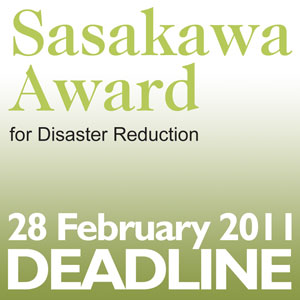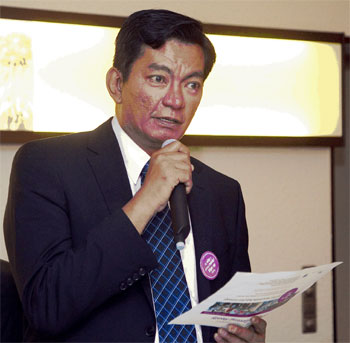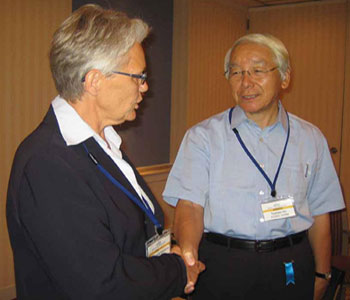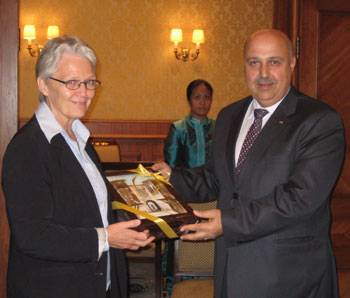In 1989, the United Nations General Assembly designated the second Wednesday of October International Day for Natural Disaster Reduction (resolution 44/236, 22 December 1989). The International Day was observed annually during the International Decade for Natural Disaster Reduction, 1990-1999.
In 2001, the General Assembly decided to maintain the observance of the International Day for Natural Disaster Reduction (resolution 56/195, 21 December 2001), as a vehicle to promote a global culture of natural disaster reduction, including disaster prevention, mitigation and preparedness.
The International Day for Disaster Reduction is an important event. It is a day to highlight the successes and to continue working toward achieving safer and more resilient communities.
This year's theme: My City is Getting Ready!
To mark the International Day for Disaster Reduction, the UNISDR secretariat is calling on its partners to play a more active role to protect cities against disasters. Many cities have been disrupted this year by disasters: earthquakes in Haiti, Chile and New Zealand; floods and heavy rainfalls in Pakistan, Eastern Europe, Mozambique and other parts of Africa; forest fires in Russia; and volcanic eruptions in Indonesia and Iceland. All have caused huge human suffering and economic damage. Cities have never been so at risk.

Secretary-General’s message for the International Day for Disaster Reduction
Biggest, deadliest, worst ever. We have seen those words in the headlines too often this year. We have used them about earthquakes, floods, hurricanes and forest fires, about loss of life and income. Those words are likely to be heard for years to come, as the climate changes and hazards multiply. To complicate the picture, just as weather patterns have altered, so has human society. We are more urban. If earthquakes, floods or storm surges were deadly in the past, they are deadlier still in an increasingly urbanized world. ...hide/show more »
Many cities are on the coasts, vulnerable to storms, inundation and sea level rise. More than a billion people in Asia live within 100 kilometres of the sea, and two-thirds of the population of Latin America and the Caribbean live within 200 kilometres. Too many people live on flood plains, others above earthquake fault lines. Some settle downstream from treeless areas, with little buffer against the elements. The risk of disaster quietly accumulates. And, while natural hazards menace everyone, the poor are by far the most vulnerable.
On the positive side, we are learning to cope. Today, on the International Day for Disaster Reduction, we recognize what local governments and communities are doing to protect themselves while building more sustainable towns and cities. Last May, the United Nations International Strategy for Disaster Reduction launched a global campaign called “Making Cities Resilient”. More than 100 cities, with nearly 110 million residents, have signed up to the “Ten Essentials” – actions that will make communities safer from disasters. The role models with good practices include Albay Province in the Philippines, Hyogo Prefecture in Japan, Bangkok, Bonn, Mexico City and Mumbai.
The Ten Essentials translate broad ideas about sustainable cities into workable solutions. They recommend that governments assign a budget to serve everyone – rich and poor alike – and that they invest in risk assessment, training on disaster risk reduction, ecosystem protection, and early warning systems. City planners must also tackle the principal sources of risk in urban areas: poor governance, planning and enforcement. Decision-making should be inclusive and participatory and the principles of sustainable urbanization must be embraced and upheld, especially for the benefit of people living in slums and informal settlements.
Reducing disaster risk is everybody's business, and needs everyone's participation and investment – civil society and professional networks as well as municipal and national governments. On this International Day for Disaster Reduction, I commend those cities that are acting to build resilience to climate, environmental and social risks. And to all others I pose this question: Is your city ready?Margareta Wahlstrom, Special Representative of the Secretary-General for Disaster Risk Reduction
Today, the 13th of October, is the International Day for Disaster Reduction. We would like all of you to join us in focusing on how, together, we can continue to reduce disaster risk. And, in particular, this year’s theme for Disaster Reduction Day is city resilience, taken from the global campaign “Making Cities Resilient: My City is Getting Ready!” Cities today are bigger and growing faster than ever in human history. ...hide/show more »
Well over 50 per cent of the world’s population lives in cities. Cities are centres for innovation, economic opportunities, economic growth, entertainment – people want to live in cities and be part of modern life!
Cities, though, are also high-risk areas because of their very rapid growth. Many governments, even with the best of intentions, cannot keep up with the enormous growth and pressure on infrastructure. Cities are also sitting in risky areas -- they are built on seismic fault lines, or lying in coastal areas; they are exposed to cyclones, hurricanes and flooding, and experience intense rainstorms and mudslides. We can see it happening all around the world, both in cities that are rich and cities that are not so rich.
Therefore, the campaign this year is calling on city leaders, the everyday population, civil society, and those engaged in science and technology to really engage with local governments. We are calling on people to use well-known methods for risk assessment, improving urban planning, and strengthening the coordination and institutions to train citizens to listen to early warning signals. We are calling on them to ensure that early warning systems are in place.
The purpose of this is to protect cities better, to protect investments, and to protect people’s lives. It is a way to ensure that, by 2015, we can achieve ‑‑ as we have committed in our common framework, the Hyogo Framework for Action ‑‑ to achieve a considerable reduction in loss of life and financial losses to disasters worldwide.
Please join us in making this campaign a strong success, so that through it, we can see how to make progress over the next five years.
Thank you very much for joining us in this campaign.
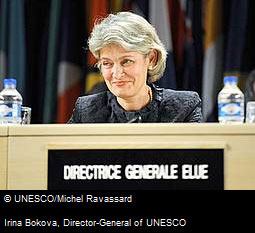
Irina Bokova, Director-General of UNESCO
Risks from natural hazards are relentless. The catastrophic earthquakes in Haiti and Chile, the massive floods in Pakistan and the wildfires across several countries have resulted in large-scale calamities and reminded the world of our vulnerability to natural disasters. The poor continue to pay the highest toll. Poorly planned development and urbanization, alteration of the natural environment, substandard dwellings and public buildings, inadequate infrastructure maintenance and grinding poverty in many communities all exacerbate the effects of natural disaster.
...hide/show more »
Yet disaster is not the necessary consequence of extreme phenomena. Today there is greater scientific understanding and technological know-how to anticipate the effects of a disaster before it strikes. Natural hazards are among the most manageable of global environmental challenges: the risks are most readily identified; effective mitigation measures are available; and the benefits of vulnerability reduction greatly outweigh the cost. The international community is quick to respond to the needs of victims of natural disasters. What is also required is to promote a culture of disaster reduction, placing the emphasis on pre-disaster action rather than contenting ourselves with post-disaster reaction.
Disaster-risk reduction is a crucial part of UNESCO’s mission. The Organization strives for better understanding and improved mitigation of the effects of natural hazards. While actively concerned with the immediate post-disaster needs of recently affected populations in Haiti and Pakistan, UNESCO is engaged in efforts to enhance the scientific and technical capacities of competent institutions in these countries to cope with the risk of similar occurrences in the future. The partners of the International Strategy for Disaster Reduction have launched a new campaign entitled Making Cities Resilient. It addresses issues of local governance and urban risk while drawing upon previous campaigns on safer schools and hospitals, as well as on the principles of sustainable urbanization. We must help local governments to develop and implement safety measures before disaster strikes. UNESCO will participate in this campaign through its various multidisciplinary programmes, and it is my hope that city authorities everywhere will rally to the urgent cause of making their cities resilient.
Flavia Pansieri, Executive Coordinator of UN Volunteers
Today, on the International Day for Disaster Reduction we think about how we can all work together to diminish and where possible prevent human losses and economic devastation caused by natural hazards worldwide. The destruction as a result of earthquakes, tropical cyclones, floods, drought or other hazards typically has a disproportionate impact on the poorest and most vulnerable especially women, children, youth and the elderly. Today, some 75% of the global population lives in areas that have been affected by these kinds of hazards at least once in the last 25 years....hide/show more »
And the indications are that as a result of climate change, the frequency and severity of disasters is increasing. Volunteers play a crucial role in coping with the aftermath of disasters, as they are often in the frontline to respond and mobilize communities to help each other. Volunteers increase the resilience of rural and urban communities to disasters through raising awareness of risk, better preparedness and identifying early warning mechanisms.
The United Nations General Assembly recognised volunteerism as an important component of any strategy aimed at disaster prevention and management as did the Hyogo Framework for Action. There is also, now, increased international acknowledgement that efforts to disaster risk reduction must be systematically mainstreamed into policies, plans and programmes for sustainable development and poverty reduction, as mutually reinforcing objectives.
The United Nations Volunteers programme has a unique contribution to make to this comprehensive effort as the UN organization that contributes to peace and development through volunteerism worldwide. We in UNV, through our volunteers, projects and programmes are actively supporting the efforts of poor communities to reduce their vulnerability to disasters and enhance their community resilience and recovery. I would like to give you a few examples of our work in this area.
In India from 2001 to 2008 UNV and UNDP along with hundreds of UNV volunteers supported the work of the Government in its efforts to develop and roll-out disaster-management plans in over 78,000 villages. These plans were built on community knowledge and resources. Working with tens of thousands of predominantly illiterate people, the UNV volunteers facilitated the development of village-specific maps, evacuation plans and contingency strategies, and helped identify and develop the capacities of local authorities and volunteer taskforces.
In China, we have been collaborating with our colleagues in UNDP in the aftermath of the Sichuan earthquake to assist the Chinese Government and affected communities in meeting the unprecedented challenges of early recovery, reconstruction and disaster risk reduction.
In Guatemala, through a partnership with a local university, volunteer graduates applied the lessons learned from Hurricane Mitch to train poor communities on disaster preparedness. Community volunteers, in turn, shared vital information about early warning systems and the benefits of clean, free-flowing rivers to prevent flooding within their neighbourhoods.
In Sri Lanka, in the aftermath of the 2004 Indian Ocean tsunami, some 40 national UNV volunteers were engaged with Disaster Management Centres to support communities in affected districts. They played a significant role in decentralizing disaster risk management. They conducted hazard, risk, vulnerability and capacity assessments and community mapping that contributed to local, district, and national disaster plans.
Based on our experience UNV strongly recommends that governments and organizations further explore the unique contribution of volunteerism to reducing risk and strengthening resilience to disasters by identifying and supporting its integration into strategic planning and monitoring processes. Reducing vulnerability to risk from disasters is in everyone’s interest, and needs everyone’s participation. Volunteerism has demonstrated to be the most inclusive, far reaching and most sustainable way of contributing to Making Cities Resilient.
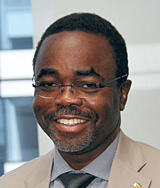
Luc Gnacadja, Executive Secretary of the UN Convention to Combat Desertification (UNCCD)
‘Making Cities Resilient’ is a most timely call to global action. Cities, from Australia, to the United States, Guatemala, Russian, Burkina Faso and all the way back to China, seem to have been under a siege from extreme weather events. Drylands cities, such as Ouagadougou in Burkina Faso and Marysville in Australia, have not been spared these effects. In the last two years, we have witnessed sever droughts, flash floods, floods and wild fires in drylands cities. Dryland areas are the third most urbanized ecosystems after coastal and cultivated systems. Urban systems occupy only 2% of the area of the drylands, but they host a large, rapidly increasing dryland population, nearly 45%. Eight of the world’s 20 megacities are located in the drylands, and six are in developing countries. Download the full message
Events
As part of the International Day for Disaster Reduction, a number of events will be taking place in cities and countries around the world. The UNISDR secretariat will also be involved in a number of activities around the world!
Press Conference, 13 October 2010 at 10am, Geneva
KazakhstanRegional launch of the Making Cities Resilient: 'My city is getting ready' world disaster reduction campaign and the 1 Million safe schools and hospitals initiative - make a pledge, save a life. |
SwitzerlandCocktail ceremony to acknowledge the 10th Anniversary of ISDR and the role of all partners in advancing efforts towards reducing disaster risk through implementation of the Hyogo Framework for Action by 2015, the current ISDR Campaign, and convey a special appeal to the private sector to commit to the 'Ten Essentials'. TajikistanEvents will consist of several activities devoted to disaster management issues, including short social animations on electronic billboards mounted in the city, the Secretary General's message translated and broadcast over national radio channels, and interviews with DRR programme managers of international organizations working in Tajikistan. |
ChinaA two-hour debate moderated by CCTV anchorman Bai Yansong with the Assistant Mayor and Secretary-General of Chengdu (site of the 2008 Sichuan earthquake) and international experts discussing about what can be done to make cities more resilient against disasters. ThailandThe ASEAN Secretariat, UNISDR, and UNESCAP are celebrating the International Day for Disaster Reduction and the ASEAN Disaster Management Day. The day will also mark the conclusion of the Regional Drawing Competition on 'My City, My Future – Making ASEAN Cities Safe from Disaster' and 'My City, My Future – Making South Asia Cities Safe from Disaster'. |
View all IDDR 2010 events here »
Media
To celebrate the International Day, UNISDR and its partners have prepared videos, slideshows, and documents that you can watch, link and download here.
Press KitThe kit contains a number of documents related to the International Day, including press release, Geneva's programme agenda, UNISDR activities around the world, the 10 Essentials of the Making Cities Resilient campaign, and an updated list of cities signed-up to the campaign.
"Making Cities Resilient"30-sec animation of the "Making Cities Resilient" campaign. Africa PSAUNISDR in collaboration with its partners in Africa produced this public service announcement for the International Day.
|
Campaign Champions
Urban Risk in Dhaka, BangladeshA profile of Bangladesh's capital city, it's rapid urbanization, and it's vulnerability to a major earthquake. UN-SPIDERUnited Nations Platform for Space-based Information for Disaster Management and Emergency Response
|
No City is Immune...Calling all partners!
This year's International Day theme is in support of the 2010-2011 World Disaster Reduction Campaign "Making Cities Resilient". The campaign addresses issues of local governance and urban risk while drawing upon previous ISDR Campaigns on safer schools and hospitals, as well as on the sustainable urbanizations principles developed in the UN-Habitat World Urban Campaign 2009-2013. UNISDR will encourage more mayors and local governments to join the 100 cities that have already signed up to the international "Making Cities Resilient" campaign.



